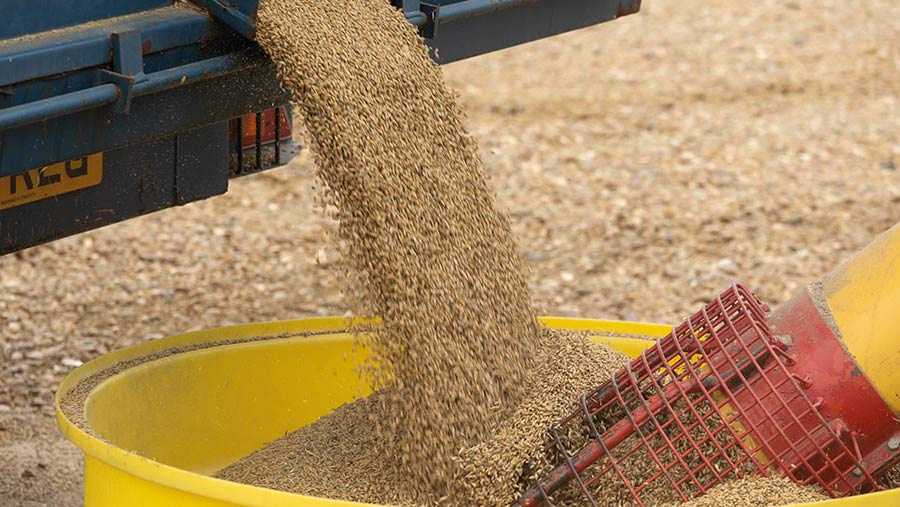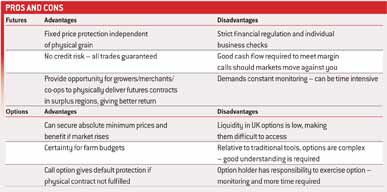So you want to… use grain futures or options
 © Tim Scrivener
© Tim Scrivener Grain futures and options provide a useful way of managing volatile grain markets, but understanding how they work is far from easy.
The futures market is a formal, regulated forward market for commodities, where set tonnages of a standard quality are traded for delivery at set times. Physical delivery takes place relatively rarely because buyers’ and sellers’ contracts are matched, effectively cancelling each other out.
Through hedging or risk management, futures markets can help protect from unfavourable price movements.
“Futures keep grain markets transparent as the prices are open for all to see. This is a huge advantage that the UK arable sector has over livestock sectors,” says HGCA economist Jack Watts.
The UK wheat market is dominated by the futures and, although the London wheat contract is a feed wheat specification, it is used to manage base prices for milling wheat and other contracts, for example, seed.
European milling wheat, malting barley and rapeseed contracts, along with other worldwide commodity futures, are also traded on the London Euronext LIFFE exchange.
There are UK wheat futures contracts for January, March, May, July and November, which is the main contract. May is also important, while volume is lower for January and March.
Ten contracts are open for trading at any one time, so that wheat can be hedged through to May 2012.
The UK wheat futures price is equivalent to a physical ex-store price, loaded on to a lorry from a registered UK futures store. This is why ex-farm prices are usually discounted by between £3 and £5/t (known as basis) compared with futures.
To protect the value of income from physical grain, a counterbalancing futures contract can be bought. A grower who wants to hold onto physical grain would typically sell futures, while those selling grain would buy futures to hedge against a price rise.
For example:
A grower budgeting to receive £100/t for his wheat might sell November futures for £105/t to secure a price cover
He retains his grain in case of a price rise
If the physical market falls by £10/t, he gets £90/t for his grain
In this case, he would buy back futures contract for £95/t, giving £10 profit on futures transaction
He has achieved a net price of £100/t for his grain
If the market rises, he gains on physical grain sale, but must buy a higher-priced futures contract to close out his obligation to deliver the first futures contract he sold.
Options
Options are a more recent introduction and are a form of price insurance. “You are paying someone to take the price risk away,” says Mr Watts. Options give the buyer the right, but not the obligation, to buy or sell a futures contract at a set price. To take advantage of this, the holder must exercise the option by a set date. A premium is paid for the option.

There are two types of option. A “put” option gives the right to sell a futures contract at a set price, protecting a minimum price for unsold grain. A “call” option (the right to buy futures at a set price) can be used following a physical grain sale to benefit from market rises.
The cost of options depends on the length of time the option has to run, the price at which it is set (the “strike” price) and recent market volatility. For example, on 13 May, an option to buy November 2010 wheat futures at £105/t would have cost £6.85/t.
“Using options gives farmers the ability to trade in confidence, for example to sell forward safe in the knowledge that they will gain if the market rises, but also having the peace of mind in a minimum price,” says Mr Watts.
For example:
November 2010 futures are at £105/t
Farmer’s ex-farm basis is -£5/t, an ex-farm equivalent of £100/t
Grower sells forward for November 2010 at £100/t
Grower also buys November 2010 call option with £105/t strike price, costing £7/t
He has set an absolute minimum price of £93/t – the £100/t ex-farm sale less £7/t option premium
Market falls £20/t, taking futures to £85/t (ex-farm equivalent £80/t), previous £100/t ex-farm sale remains
Call option premium of £7/t has been paid, but option does not pay out because market has fallen – grower achieves minimum price of £93/t
If market rises £20/t to put futures at £125/t (ex-farm equivalent £120/t), previous £100/t ex-farm sale remains
Call option premium of £7/t has been paid – option pays out £20/t – difference between option strike price of £105 and current future price of £125/t, so the grower achieves £113/t, comprising £100/t ex-farm sale, less £7/t option premium plus £20/t option payout.
Futures or options?
Farmers can use their grain merchant or co-op to conduct futures and options business for them, or go direct to a futures broker. Trades must be done through a member firm of London’s Euronext LIFFE exchange, although brokers who are not members (sometimes called introductory brokers) can transact futures business, putting it through an exchange member.
Relatively few brokers will manage individual accounts, such as those likely to be run by farmers. At Berkeley Futures, associate director Steve Mason handles farmer accounts that typically trade six each of futures and options contracts.
Brokers will want to establish that customers have appropriate backing and facilities to trade, so be prepared for questions on personal wealth and to pay an initial deposit, typically £10,000, to open an account, he says.
For those trading as a company, initial deposits may be higher – Berkeley requires £15,000 for corporate accounts. Margin payments, to cover exposure when the market moves against a position, are drawn from this initial amount. Further requests will be made to top it up as necessary. Those requests must be met on the day they are made, so staying in touch and having things set up to meet additional demands is important.
Commission will also be charged, for example, 25p/t for each trade at Berkeley Futures, for a service including advice. Execution only, which involves taking an order and making the transaction only, costs less. Most brokers provide an online service where the customer can execute his own business, but this is generally not advised for first-time users, unless they are taking advice elsewhere. Options may also be available through the treasury department of a grower’s bank.
Merchants and co-ops also provide their own options-linked contracts, such as minimum-price guarantee contracts or min/max contracts, but check the wording carefully, warns Mr Watts, especially how the strike price is established, expiry dates and obligations on merchant and grower, and whether the option covers the whole contract tonnage.
CASE STUDY: Tim Breitmeyer, Bartlow Estate in Cambridgeshire
Tim Breitmeyer has sold half of his oilseed rape crop forward for harvest and May, backing this by buying call options to mirror the movement of physical sales.
The rape futures market has risen by more than the cost of the €11/t (£9.36/t) option premium. Having set a minimum price for his rape by selling physical seed and buying the option, the final price can be improved by exercising the option if the market continues to rise.
The transaction was made on the Euronext market in euros, the currency in which the oilseed rape contract is traded. Hedging in a different currency poses an exchange rate risk, which is mitigated by the use of a euro account, he says.
This was Mr Breitmeyer’s first independent options transaction and was made through a broker on an execution-only basis, as Offre & Demande Agricole’s advice service is used to help form his crop marketing strategy. ODA is a French company with a UK office offering training and advice on the grain market through courses and a subscription-based news service.
“We’ve got to become masters in using risk management tools if we are to iron out the price volatility and maintain stable profit,” says Mr Breitmeyer. He warns that futures brokers may ask searching questions of farmers setting up accounts.
